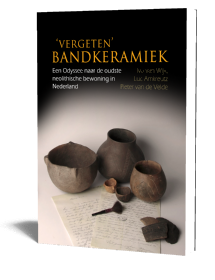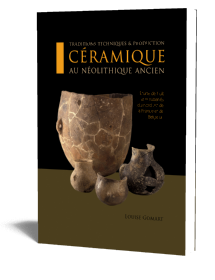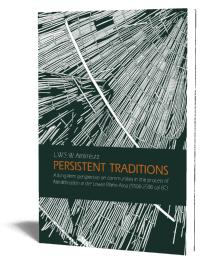Contacts, boundaries and innovation in the fifth millennium
Exploring developed Neolithic societies in central Europe and beyond
Edited by Ralf Gleser & Daniela Hofmann | 2019
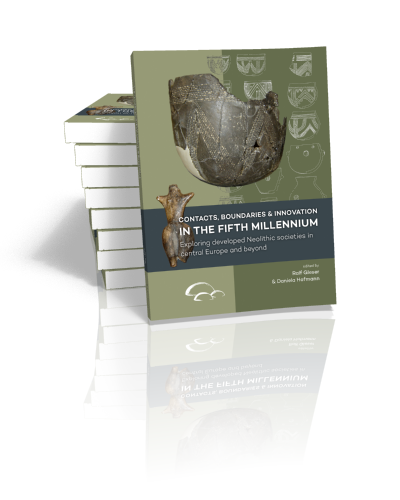
Contacts, boundaries and innovation in the fifth millennium
Exploring developed Neolithic societies in central Europe and beyond
Edited by Ralf Gleser & Daniela Hofmann | 2019
Paperback ISBN: 9789088907142 | Hardback ISBN: 9789088907159 | Imprint: Sidestone Press | Format: 210x280mm | 336 pp. | Language: English | 73 illus. (bw) | 56 illus. (fc) | Keywords: Neolithic Europe, culture concept, cultural boundaries, communication, social change | download cover
Read online or downloaded 1048 times
-
Digital & Online access
This is a full Open Access publication, click below to buy in print, browse, or download for free.
-
Buy via Sidestone (EU & UK)
-
Buy via our Distributors (WORLD)
For non-EU or UK destinations you can buy our books via our international distributors. Although prices may vary this will ensure speedy delivery and reduction in shipping costs or import tax. But you can also order with us directly via the module above.
UK international distributor
USA international distributor
-
Bookinfo
Paperback ISBN: 9789088907142 | Hardback ISBN: 9789088907159 | Imprint: Sidestone Press | Format: 210x280mm | 336 pp. | Language: English | 73 illus. (bw) | 56 illus. (fc) | Keywords: Neolithic Europe, culture concept, cultural boundaries, communication, social change | download cover
Read online or downloaded 1048 times

We will plant a tree for each order containing a paperback or hardback book via OneTreePlanted.org.
The fifth millennium is characterized by far-flung contacts and a veritable flood of innovations. While its beginning is still strongly reminiscent of a broadly Linearbandkeramik way of life, at its end we find new, inter-regionally valid forms of symbolism, representation and ritual behaviour, changes in the settlement system, in architecture and in routine life. Yet, these inter-regional tendencies are paired with a profusion of increasingly small-scale archaeological cultures, many of them defined through pottery only. This tension between large-scale interaction and more local developments remains ill understood, largely because inter-regional comparisons are lacking.
Contributors in this volume provide up-to-date regional overviews of the main developments in the fifth millennium and discuss, amongst others, in how far ceramically-defined ‘cultures’ can be seen as spatially coherent social groups with their own way of life and worldview, and how processes of innovation can be understood.
Case studies range from the Neolithisation of the Netherlands, hunter-gatherer – farmer fusions in the Polish Lowlands, to the Italian Neolithic. Amongst others, they cover the circulation of stone disc-rings in western Europe, the formation of post-LBK societies in central Europe and the reliability of pottery as an indicator for social transformations.
List of contributors
The fifth millennium: the emergence of cultural diversity in central European prehistory
Daniela Hofmann and Ralf Gleser
Part 1: Diverse populations
On the periphery and at a crossroads: a Neolithic creole society on the Lower Vistula in the fifth millennium BC
Peter Bogucki
The Brześć Kujawski culture. The north-easternmost Early Chalcolithic communities in Europe
Lech Czerniak and Joanna Pyzel
Taboo? The process of Neolithisation in the Dutch wetlands re-examined (5000–3400 cal BC)
D.C.M. Raemaekers
Part 2: Interaction and change
The fifth millennium BC in central Europe. Minor changes, structural continuity: a period of cultural stability
Christian Jeunesse
Early Middle Neolithic pottery decoration — different cultural groups or just one supraregional style of its time?
Karin Riedhammer
The oldest box-shaped wooden well from Saxony-Anhalt and the Stichbandkeramik culture in central Germany
René Wollenweber
A vessel with zoomorphic depiction from the Epi-Rössen horizon at Oberbergen am Kaiserstuhl: an evolutionary perspective on an unusual artefact
Ralf Gleser
Part 3: Community, interaction and boundaries
Strategies of boundary making between northern and southern Italy in the late sixth and early fifth millennium BC
Valeska Becker
The transition from the sixth to the fifth millennium BC in the southern Wetterau — pottery as expression of contacts, boundaries and innovation
Johanna Ritter-Burkert
On the relationship of the Michelsberg culture and Epirössen groups in south-west Germany in the light of absolute chronology, aspects of culture definition, and spatial data
Ute Seidel
Schiepzig enclosures: gaps in the archaeological record at the end of the fifth millennium BC in northern central Germany?
Johannes Müller, Kay Schmütz and Christoph Rinne
The jadeitite-omphacitite and nephrite axeheads in Europe: the case of the Czech Republic
Antonín Přichystal, Josef Jan Kovář, Martin Kuča and Kateřina Fridrichová
Disc-rings of Alpine rock in western Europe: typology, chronology, distribution and social significance
Pierre Pétrequin, Serge Cassen, Michel Errera, Yvan Pailler, Frédéric Prodéo, Anne-Marie Pétrequin and Alison Sheridan
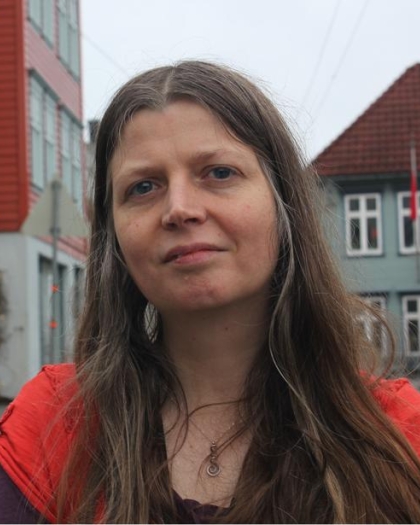
Prof. Dr. Daniela Hofmann
Daniela Hofmann is Professor of Archaeology at Bergen University, where she teaches and researches mainly on the Neolithic of Europe. Her current interests include migration, kinship, ritual, social inequality and resistance to it, as well as social contacts and change (see the forthcoming co-authored volume Negotiating migrations. The archaeology and politics of mobility, 2024, and the co-edited outreach publication Migration narratives in archaeology, 2023). In her projects, she tries to combine theoretical considerations with a variety of methods, including bioarchaeological information, in an effort to write narratives that take into account different perspectives. She hopes that knowing about diversity in the past could help us create a fairer society today, but has doubts on whether this is actually working.
Prof. dr. Ralf Gleser
Ralf Gleser holds the chair of Pre- and Protohistory at Münster University. One of his main research interests is the cultural development of central and south-east Europe in the Neolithic and Copper Age, with a particular focus on identities and material culture, early metallurgy, culture areas and cultural boundaries in the fifth and fourth millennia BC.
Abstract:
The fifth millennium is characterized by far-flung contacts and a veritable flood of innovations. While its beginning is still strongly reminiscent of a broadly Linearbandkeramik way of life, at its end we find new, inter-regionally valid forms of symbolism, representation and ritual behaviour, changes in the settlement system, in architecture and in routine life. Yet, these inter-regional tendencies are paired with a profusion of increasingly small-scale archaeological cultures, many of them defined through pottery only. This tension between large-scale interaction and more local developments remains ill understood, largely because inter-regional comparisons are lacking.
Contributors in this volume provide up-to-date regional overviews of the main developments in the fifth millennium and discuss, amongst others, in how far ceramically-defined ‘cultures’ can be seen as spatially coherent social groups with their own way of life and worldview, and how processes of innovation can be understood.
Case studies range from the Neolithisation of the Netherlands, hunter-gatherer – farmer fusions in the Polish Lowlands, to the Italian Neolithic. Amongst others, they cover the circulation of stone disc-rings in western Europe, the formation of post-LBK societies in central Europe and the reliability of pottery as an indicator for social transformations.
Contents
List of contributors
The fifth millennium: the emergence of cultural diversity in central European prehistory
Daniela Hofmann and Ralf Gleser
Part 1: Diverse populations
On the periphery and at a crossroads: a Neolithic creole society on the Lower Vistula in the fifth millennium BC
Peter Bogucki
The Brześć Kujawski culture. The north-easternmost Early Chalcolithic communities in Europe
Lech Czerniak and Joanna Pyzel
Taboo? The process of Neolithisation in the Dutch wetlands re-examined (5000–3400 cal BC)
D.C.M. Raemaekers
Part 2: Interaction and change
The fifth millennium BC in central Europe. Minor changes, structural continuity: a period of cultural stability
Christian Jeunesse
Early Middle Neolithic pottery decoration — different cultural groups or just one supraregional style of its time?
Karin Riedhammer
The oldest box-shaped wooden well from Saxony-Anhalt and the Stichbandkeramik culture in central Germany
René Wollenweber
A vessel with zoomorphic depiction from the Epi-Rössen horizon at Oberbergen am Kaiserstuhl: an evolutionary perspective on an unusual artefact
Ralf Gleser
Part 3: Community, interaction and boundaries
Strategies of boundary making between northern and southern Italy in the late sixth and early fifth millennium BC
Valeska Becker
The transition from the sixth to the fifth millennium BC in the southern Wetterau — pottery as expression of contacts, boundaries and innovation
Johanna Ritter-Burkert
On the relationship of the Michelsberg culture and Epirössen groups in south-west Germany in the light of absolute chronology, aspects of culture definition, and spatial data
Ute Seidel
Schiepzig enclosures: gaps in the archaeological record at the end of the fifth millennium BC in northern central Germany?
Johannes Müller, Kay Schmütz and Christoph Rinne
The jadeitite-omphacitite and nephrite axeheads in Europe: the case of the Czech Republic
Antonín Přichystal, Josef Jan Kovář, Martin Kuča and Kateřina Fridrichová
Disc-rings of Alpine rock in western Europe: typology, chronology, distribution and social significance
Pierre Pétrequin, Serge Cassen, Michel Errera, Yvan Pailler, Frédéric Prodéo, Anne-Marie Pétrequin and Alison Sheridan

Prof. Dr. Daniela Hofmann
Daniela Hofmann is Professor of Archaeology at Bergen University, where she teaches and researches mainly on the Neolithic of Europe. Her current interests include migration, kinship, ritual, social inequality and resistance to it, as well as social contacts and change (see the forthcoming co-authored volume Negotiating migrations. The archaeology and politics of mobility, 2024, and the co-edited outreach publication Migration narratives in archaeology, 2023). In her projects, she tries to combine theoretical considerations with a variety of methods, including bioarchaeological information, in an effort to write narratives that take into account different perspectives. She hopes that knowing about diversity in the past could help us create a fairer society today, but has doubts on whether this is actually working.
Prof. dr. Ralf Gleser
Ralf Gleser holds the chair of Pre- and Protohistory at Münster University. One of his main research interests is the cultural development of central and south-east Europe in the Neolithic and Copper Age, with a particular focus on identities and material culture, early metallurgy, culture areas and cultural boundaries in the fifth and fourth millennia BC.
-
Digital & Online access
This is a full Open Access publication, click below to buy in print, browse, or download for free.
-
Buy via Sidestone (EU & UK)
-
Buy via our Distributors (WORLD)
For non-EU or UK destinations you can buy our books via our international distributors. Although prices may vary this will ensure speedy delivery and reduction in shipping costs or import tax. But you can also order with us directly via the module above.
UK international distributor
USA international distributor
- Browse all books by subject
-
Search all books

We will plant a tree for each order containing a paperback or hardback book via OneTreePlanted.org.
You might also like:
© 2025 Sidestone Press KvK nr. 28114891 Privacy policy Sidestone Newsletter Terms and Conditions (Dutch)
